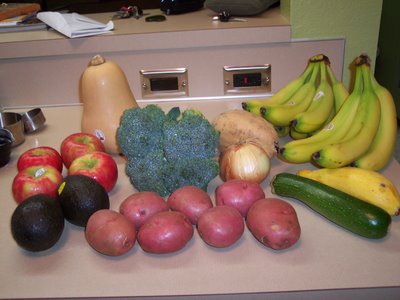Protein Primavera and Whatcha Eatin'? #1
Recently I saw some great pasta on Megan's
blog. I've been waiting to make this all week, but I had to keep putting it off because I had one ingredient or another that I needed to cook with because it was going to go bad if I didn't... so tonight was the night! I made bowtie pasta with a roasted garlic and cannellini bean sauce and some steamed broccoli. 
We also enjoyed some Ciabata bread with bruschetta and garlic buttah. For the sauce, I roasted a whole head of garlic, then reserved about 1 tablespoon for the garlic bread. I pureed the rest with a can of cannellini beans, a splash of soy milk, some oregano, a splash of lemon and some olive oil. Then I heated it on the stove top while everything else was cooking, adding soy milk as needed to thin it out. It was SO good and much more substantially filling than just plain starchy pasta with a flour based cream sauce.
Do you ever have those moments when you look at something you're eating or cooking with and think "Wow, I have no actual idea where this comes from..."? Well, I do and to help myself learn and become more aware of my food and to add a new (and hopefully engaging) feature to my blog, I'm going to start a weekly column called "Whatcha Eatin'?" where we can explore some of the things that we consume.
Up this week: cinnamon. 
I was cooking with cinnamon the other night and I thought "Where does cinnamon come from"? My first thought to that was "Well, from cinnamon sticks". But where do those come from?
Cinnamon may seem like an unassuming spice on your rack, but it has a dirty little secret. It turns out that it has a related species called "cassia" and that is actually what many of us have in our spice bottles in the US. Nope, no true cinnamon for you, what you have is cinnamon's sidekick, masquerading under its name. Is that so bad though? I guess it depends. There are many kinds of cinnamon and one can only imagine what they all taste like, but cassia has a stronger flavor, so maybe it's not so bad after all. Cinnamon is lighter colored and finer when ground and has a sweeter flavor than cassia.
But where does it come from? Cinnamon, cassia, the stuff in your pumpkin pie, comes from a tree. The trees are cut to a stump, from which little shoots grow out. These shoots are stripped of their bark and dried, making cinnamon sticks.
Cinnamon was once considered more precious than gold and was used as a currency in ancient civilizations. It was used for embalming and in medicines in ancient Egypt. While it grew in Europe, spice trade opened up a world of exotic cinnamon to try. Studies done in the past few years in the US have shown that cinnamon (cassia as well, presumably) is very high in antioxidents and may be beneficial for diabetics and in lowering high blood pressure.
Pretty interesting, huh? This kind of stuff really fascinates me, so if it bores you, just let me geek out for the moment and it will pass... :)

































